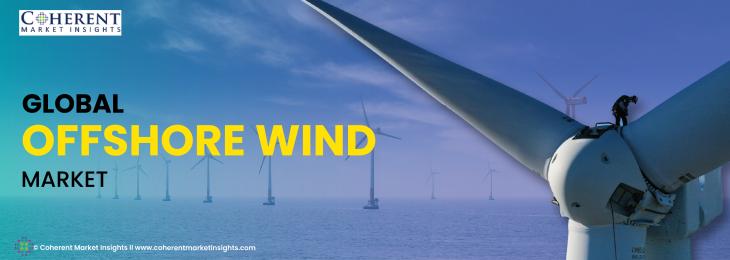
The necessity to minimize carbon emissions, the depletion of fossil fuels, climatic change, etc. have all contributed to a dramatic movement in the energy sector toward renewable and green energy. The government has put in place a number of policies to help the transition to greener energy. Many multinational corporations are making efforts to reduce their carbon footprint in order to help the environment and promote sustainability. By 2050, Equinor (Norway), for instance, wants to reduce its carbon emissions by 50%. The goal includes expanding its renewable energy companies, particularly offshore wind, which could provide 16,000 megawatts of power in 15 years and 6,000 megawatts in six years. Another such is the agreement that the energy behemoth Total made with SSE Renewables to purchase a 51% interest in the latter's Seagreen offshore wind farm project. For this initiative, Total expects to invest 70 million euros.
According to Coherent Market Insights, The value of the global Offshore Wind Market was estimated to be US$ 41.8 billion in 2022, and it is anticipated to increase from US$ 47.4 billion in 2023 to US$ 131.4 billion by 2030, with a compound annual growth rate (CAGR) of 15.68% throughout the forecast period (2023 - 2030).
Leading Companies in the Offshore Wind Industry:
1. GE Healthcare
The firm was founded in 1892 and is based in Boston, Massachusetts, United States. A global leader in financial services and technology, General Electric Company. The company offers a range of goods and services, from industrial goods to medical imaging, corporate and consumer financing, water treatment, and home appliances. To increase the global availability of HA gas turbine services, GE will expand the scope of its Singapore repair centre in June 2023.
2. MHI Vestas
The company was started in 2014 and has its main office Aarhus, Midtjylland, Denmark. The company's main business is designing, producing, installing, and maintaining wind turbines for the offshore wind sector. By promoting capital and operating savings and boosting wind turbine output, the company hopes to generate sustainable value through offshore wind power.
3. Siemens AG
The company was founded in 1847 and is based in Munich and Berlin, Germany. The Company is heavily invested in digitalization, automation, and electrification. Siemens purchased Wattsense, a maker of IoT hardware and software for buildings, in October 2021 for an unknown fee. For an unknown fee, Siemens purchased a 77% majority share in the Indian building solutions company iMetrex Technologies in April 2020.
4. ABB, Ltd.
The firm was started in 1988 and is based in Zürich, Switzerland. Construction and engineering projects are taken on by the business, which also produces heavy industrial and engineering equipment. ABB and Eve Systems reached an acquisition agreement in June 2023. ABB launched a massive robotics plant in Shanghai in December 2022. The new 67,000 square meter building cost $150 million to build.
5. EEW Group,
The company was founded in 1936 and is located Nordrhein Westfalen, Germany. The German company Erndtebrücker Eisenwerk, better known as EEW, has been supplying steel pipes and offering services to a variety of sectors for more than 30 years. One of the top experts in submerged-arc welded (SAW) pipes is EEW.
6. Nexans
The firm was founded in 2000 and is based in Paris, France. In addition to control cables for residential, commercial, and industrial buildings, bare expenses conductors, below ground primary cables, and overhead secondary distribution cables, the company offers direct buried, component copper, conduit, unarmored and armored, and wires and cables. A new facility opened in China in 2021.
7. A2SEA A/S
The company was started in 2000 and is located in Syddanmark, Denmark. Motors and generators are produced and sold by A2SEA A/S. The company sells its goods to builders of wind farms throughout northern Europe. A2SEA provided installation and maintenance services for offshore wind farms.
Definition: The electrical energy needed to gather wind energy on the continental shelf is provided by offshore wind. Compared to on land, wind speed is typically stronger and more consistent offshore. There is no longer a need for additional overland transmission lines because offshore wind farms are situated close to coastal regions.










